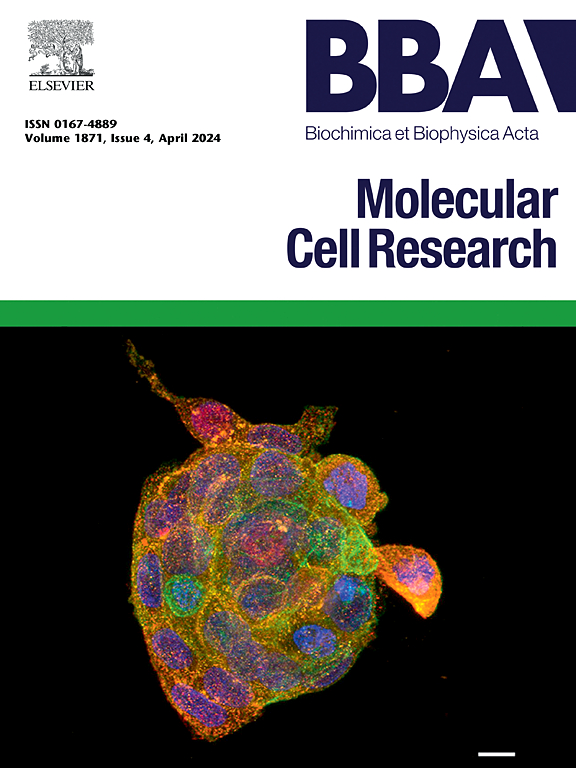Inhibition of the Sp1/PI3K/AKT signaling pathway exacerbates doxorubicin-induced cardiomyopathy
IF 3.7
2区 生物学
Q1 BIOCHEMISTRY & MOLECULAR BIOLOGY
Biochimica et biophysica acta. Molecular cell research
Pub Date : 2025-04-15
DOI:10.1016/j.bbamcr.2025.119960
引用次数: 0
Abstract
Objective
This study aimed to investigate the interaction and underlying mechanisms between specificity protein 1 (Sp1) and the phosphoinositide 3-kinase/protein kinase B (PI3K/AKT) signaling pathway in the context of doxorubicin-induced cardiomyopathy (DIC).
Methods
A rat model of DIC was established by intraperitoneal injection of doxorubicin (1 mg/kg) twice a week for eight weeks. Cardiac function was evaluated using echocardiography, and myocardial histopathology was assessed by hematoxylin-eosin (HE) staining. In vitro, H9c2 cardiomyocytes were treated with doxorubicin (2 μmol/L) to induce cardiotoxicity, followed by co-treatment with the Sp1 inhibitor plicamycin or the PI3K/AKT inhibitor LY294002. Cell viability was measured by the CCK-8 assay. Oxidative stress markers, including reactive oxygen species (ROS) and lactate dehydrogenase (LDH), were quantified using flow cytometry and colorimetric assays. Apoptosis was detected via TUNEL staining, and protein expression of Sp1, PI3K, AKT, and Caspase-3 was analyzed by Western blotting.
Results
Doxorubicin treatment significantly impaired cardiac function in rats, as evidenced by an increase in both left ventricular internal diameters during diastole (LVIDd) and systole (LVIDs), along with decreased ejection fraction (EF) and fractional shortening (FS) (p < 0.01). Myocardial HE staining in doxorubicin-treated rats revealed disorganized cardiomyocyte structures, edema, and cellular necrosis. In vitro, doxorubicin exposure led to reduced H9c2 cell viability, elevated ROS and LDH levels, and increased apoptosis rates (p < 0.01). Western blotting demonstrated that doxorubicin significantly downregulated the expression of Sp1, PI3K, and AKT while upregulating Caspase-3. Inhibition of Sp1 or PI3K/AKT exacerbated these effects, resulting in further cardiac dysfunction, oxidative stress, and apoptosis. Moreover, Sp1 inhibition led to decreased PI3K/AKT pathway activation, while PI3K/AKT inhibition reciprocally suppressed Sp1 expression, indicating a bidirectional regulatory relationship.
Conclusion
Doxorubicin induces cardiotoxicity by promoting oxidative stress and apoptosis through the downregulation of the Sp1/PI3K/AKT signaling pathway. Inhibition of this pathway exacerbates cardiac injury, suggesting that targeting Sp1 and PI3K/AKT may offer novel therapeutic strategies for the prevention and treatment of DIC.
抑制Sp1/PI3K/AKT信号通路可加重阿霉素诱导的心肌病
目的探讨特异性蛋白1 (Sp1)与磷酸肌苷3-激酶/蛋白激酶B (PI3K/AKT)信号通路在阿霉素诱导的心肌病(DIC)中的相互作用及其机制。方法采用阿霉素(1 mg/kg)腹腔注射,每周2次,连续8周,建立大鼠DIC模型。超声心动图评价心功能,苏木精-伊红(HE)染色评价心肌组织病理学。在体外,用多柔比星(2 μmol/L)处理H9c2心肌细胞诱导心脏毒性,然后与Sp1抑制剂plicamycin或PI3K/AKT抑制剂LY294002共同处理。CCK-8法测定细胞活力。氧化应激标志物,包括活性氧(ROS)和乳酸脱氢酶(LDH),采用流式细胞术和比色法定量。TUNEL染色检测细胞凋亡,Western blotting检测Sp1、PI3K、AKT、Caspase-3蛋白表达。结果阿霉素治疗显著损害了大鼠心功能,舒张期(LVIDd)和收缩期(LVIDs)左心室内径均增加,射血分数(EF)和分数缩短(FS)均降低(p <;0.01)。阿霉素处理大鼠心肌HE染色显示心肌细胞结构紊乱、水肿和细胞坏死。在体外,阿霉素暴露导致H9c2细胞活力降低,ROS和LDH水平升高,凋亡率增加(p <;0.01)。Western blotting结果显示,阿霉素显著下调Sp1、PI3K和AKT的表达,上调Caspase-3的表达。Sp1或PI3K/AKT的抑制加重了这些作用,导致进一步的心功能障碍、氧化应激和细胞凋亡。此外,Sp1抑制导致PI3K/AKT通路激活降低,而PI3K/AKT抑制反过来抑制Sp1表达,表明双向调节关系。结论阿霉素通过下调Sp1/PI3K/AKT信号通路,促进氧化应激和细胞凋亡,从而诱导心肌毒性。抑制该通路会加重心脏损伤,提示靶向Sp1和PI3K/AKT可能为预防和治疗DIC提供新的治疗策略。
本文章由计算机程序翻译,如有差异,请以英文原文为准。
求助全文
约1分钟内获得全文
求助全文
来源期刊
CiteScore
10.00
自引率
2.00%
发文量
151
审稿时长
44 days
期刊介绍:
BBA Molecular Cell Research focuses on understanding the mechanisms of cellular processes at the molecular level. These include aspects of cellular signaling, signal transduction, cell cycle, apoptosis, intracellular trafficking, secretory and endocytic pathways, biogenesis of cell organelles, cytoskeletal structures, cellular interactions, cell/tissue differentiation and cellular enzymology. Also included are studies at the interface between Cell Biology and Biophysics which apply for example novel imaging methods for characterizing cellular processes.

 求助内容:
求助内容: 应助结果提醒方式:
应助结果提醒方式:


